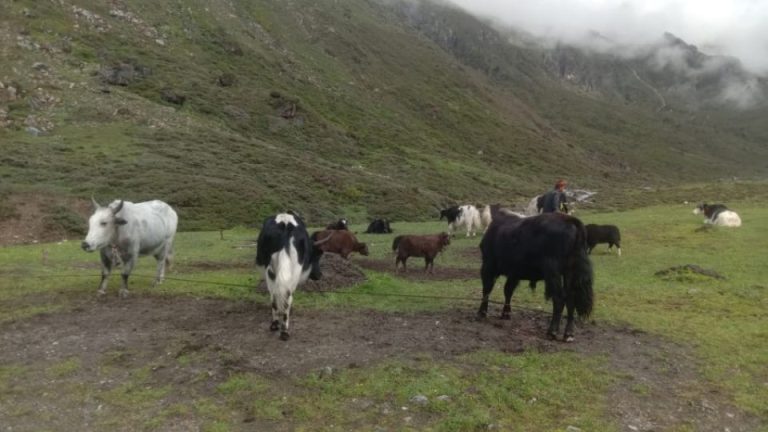Nepal’s yak herders are facing severe financial struggles as they remain unable to sell their livestock due to Tibet’s ongoing trade restrictions. Once a thriving business, yak and chauri farming is now an unsustainable livelihood, forcing many herders to consider quitting.
Nupu Sherpa, a 24-year-old yak farmer from Papung village in Mikwakhola Rural Municipality, owns 80 yaks and 10 chauris. He moves his herd across different pastures, facing extreme weather conditions. But for the past four years, he has earned nothing from his livestock.
“Each year, 25 to 30 calves are born, but 15 to 20 die due to disease, wild animal attacks, or old age. Instead of making a living, I feel like I am just counting life and death,” Nupu said. His plan to sell older yaks and reinvest in younger ones has failed because many animals die before they can be sold. “It’s heartbreaking to watch them grow old and die because I can’t sell them in time,” he added.
The Effect of Border Closures on Yak Farmers
Before the COVID-19 pandemic, yak and chauri farming was a profitable business in eastern Nepal, including Taplejung, Panchthar, Ilam, Tehrathum, Sankhuwasabha, and Solukhumbu. Farmers raised these animals in high-altitude pastures and sold them in Tibet and Sikkim, India. However, despite borders reopening for general trade, livestock exports remain banned.
Naike Chungdak Sherpa, another herder, owned 250 yaks and chauris last year. But he lost 67 animals to lumpy skin disease. Frustrated with ongoing losses, he plans to sell all his livestock if trade resumes. “I can’t keep doing this. If the market opens, I will sell everything and leave this business,” he said.
Yak farmers typically earn large sums from selling livestock. Nupu estimates that selling his 90 yaks and chauris in Tibet would bring him NPR 9 million. “In Tibet, yaks currently sell for NPR 800,000 to NPR 1.2 million each,” he explained. But with trade halted, farmers are left with no income while their costs keep rising.
Yak Farming: A Tough Business
Yak and chauri farming is demanding work. Farmers move their herds throughout the year, braving freezing temperatures, heavy rains, and landslides. These animals provide milk, which is made into ghee, yogurt, and hardened cheese (chhurpi). But with limited local demand, farmers must send products to district markets and wait months for payment.
A chauri produces up to four liters of milk per day, while a yak produces about three liters. However, milk production is low, and it takes 12 to 13 yaks or chauris to make just one kilogram of ghee, which sells for NPR 1,000. The income barely covers expenses like salt, fodder, and pasture fees.
The Taplejung Livestock Service Office reports that the district has about 8,500 yaks and chauris. Of these, 3,500 are in Mikwakhola Rural Municipality and 2,500 in Faktanglung Rural Municipality. If the border reopens, at least 5,000 yaks and chauris are ready for immediate sale. Tibetan buyers prefer high-quality breeds for milk and meat, sometimes paying up to NPR 150,000 per animal.
Will the Government Help?
Before the pandemic, Nepalese farmers exported yaks and chauris to Tibet without issue. Nupu recalled selling 20 yaks in Dinggye County, Tibet, just before the pandemic, earning NPR 1.8 million.
Currently, despite the reopening of border points like Tipta La in Taplejung and Kimathanka in Sankhuwasabha, livestock trade remains closed. Farmers believe China’s concerns over lumpy skin disease might be the reason, but officials have not given a clear explanation.
Netra Prasad Sharma, the Chief District Officer of Taplejung, raised the issue with Chinese officials in Dinggye County. “We stressed the need to reopen livestock trade, and the Chinese side acknowledged our concerns,” Sharma said. “However, they said the decision must come from higher authorities.”
Local leaders continue pushing for a resolution, knowing that without trade, Nepal’s yak farmers have no future. “We urge the government to act quickly and reopen the livestock market,” Sharma added.
What’s Next for Nepal’s Yak Farmers?
For now, herders like Nupu and Naike have no choice but to wait. The longer trade stays closed, the more financial trouble they face. Many are ready to quit if the government doesn’t intervene.
Yak farming has been a tradition for generations in Nepal’s mountains. But without access to buyers in Tibet, the industry is at risk of collapse. “If this continues, we will have no option but to give up,” Nupu warned.


